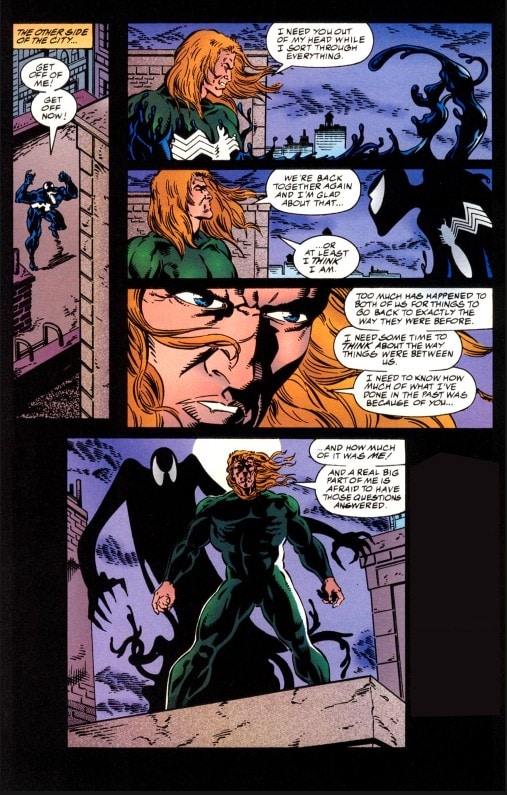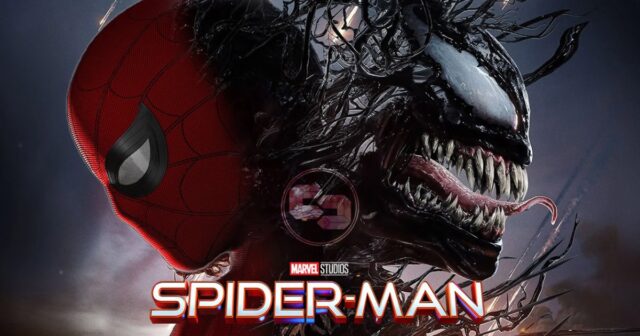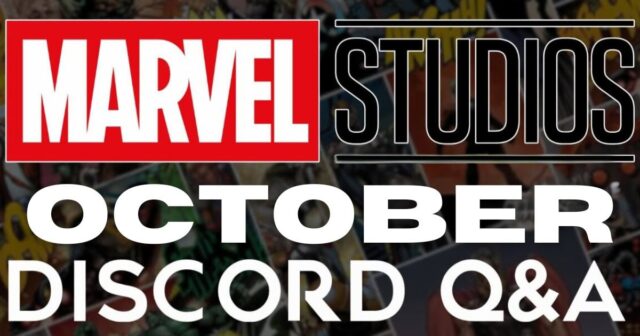Marvel Spotlight: ‘Venom: Separation Anxiety’ & ‘Planet of the Symbiotes’

The story of Venom in Marvel Comics is always complicated. He was created in 1988 and immediately became one of Spider-Man’s most terrifying foes. Venom was brutal, ruthless, uncanny, and evil. As an offspring of a symbiote from Spider-Man’s Secret Wars suit, he had a deep connection with Peter Parker. In the later story of Spider-Man, this became a key relationship in the Marvel Universe.
After Spider-Man rejected the symbiote, it found a new host in Eddie Brock. Brock hated Peter, and when the symbiote felt it, it decided to bond with him, therefore creating Venom. After this happened, Venom had many beefs with Spidey and other characters. They were always an important part of this world, and they still are. It doesn’t matter if they appear in games, movies, TV shows, or comic books. Whenever Spidey has to fight Venom, it’s always an important event.
The importance of Venom in a larger Marvel Universe was also a big part of the live-action projects. He appeared in Spider-Man 3 as a villain, was meant to be one of the villains in The Amazing Spider-Man 3, and now has his own trilogy of movies. The most interesting thing to explore in Venom’s story is the relationship between the symbiote and the host. This was always and will always be the most crucial part of this character. Their problems, social anxiety, and two different brains in one body. This is the reason why Venom is such an interesting and unique Marvel character.
[Warning: some mild spoilers discussed for these Venom comics below.]
Exploring Eddie & Venom’s relationship in Separation Anxiety & Planet of the Symbiotes
Venom comics are full of psychological motives and deep relationships. It’s not different in the case of the interconnected narratives of Venom: Separation Anxiety and Venom: Planet of the Symbiotes. These two stories are one of the deepest short story arcs of Eddie Brock and Venom. They give us two important chapters in the life and evolution story of Eddie Brock and his relationship with the Venom symbiote.
Each comic explores the symbiote’s mythology while exploring themes of identity, co-dependency, and survival in a world increasingly hostile to the alien bond shared by Brock and Venom, all at the same time. While both stories stand on their own, they share a meaningful connection that enlarges the Venom mythos, navigating readers through Eddie Brock’s psychological battle with the symbiote, and eventually exploring the symbiote race itself.
Separation Anxiety is the first more important story in this arc. From the beginning, it sets the tone by focusing on the deeply personal struggle between Eddie and Venom. The story opens with Brock experiencing growing anxiety regarding the extent to which his life has become connected with the alien organism. Venom, once a harbinger of revenge and destruction, is now presented as a sentient being that Eddie can no longer view as a mere tool.
The story is focused on exploring the painful separation of Eddie from Venom. It is a meaningful event, that heavily serves as a metaphor for the emotional pain of addiction or the severance of a toxic relationship. The title itself is a confirmation that this comic book focuses mainly on the theme of anxiety and suffering resulting from this forced separation. Which, as it happens, is not only physical but deeply psychological. Eddie struggles to find his own identity without Venom. In the end, it leaves him lost and mentally broken.
This internal conflict shows the external chaos caused by the reappearance of Venom’s symbiotic offspring, who serve as the primary antagonists. Riot, Scream, Phage, Lasher, and Agony are introduced as a united collective, each with distinct abilities and personalities. These symbiotes are bred from the original Venom symbiote. Each of them is a reflection of Eddie’s own darker impulses. They aren’t merely villains of this story. They are manifesting their own existence to show the darker sides of Eddie Brock.

Without spoiling too much, Separation Anxiety is a thrilling story that takes the characters of Eddie Brock and Venom and shows them to the reader as completely new characters. It’s an amazing story that doesn’t hold itself when it comes to exploring themes of depression, finding your true self. Eddie doesn’t know If everything that happened was because he wanted this, or because Venom did, and that’s the real problem of this story. Venom and Eddie did many bad things together, but which one was responsible for it? Venom? Eddie? Both of them? Who knows?
After Separation Anxiety ends, the main story arc of Eddie and Venom transitions into Planet of the Symbiotes, which expands upon the themes introduced in Separation Anxiety and takes the narrative in a more cosmic direction. Here, Eddie’s psychological problems are once again the main topic of the story. His rejection of Venom leads to a ripple effect on a galactic scale. When Eddie pushes Venom away, the symbiote’s psychic distress call summons an entire race of symbiotes to Earth, transforming the planet into a battleground. Separation Anxiety focuses on a more personal and emotional conflict, but Planet of the Symbiotes escalates the stakes to a global, even intergalactic scale.
In Planet of the Symbiotes, the invasion by the symbiote race is a literal representation of the internal struggle Eddie has been facing. The symbiotes, as a species, seek to dominate and assimilate, much like the Venom symbiote’s influence over Eddie. Their parasitic nature threatens not only the Earth, but also the very concept of individuality, as they seek to bond with and control human hosts. Eddie, who spent so long trying to reject Venom, realizes that he must come to terms with the symbiote to save humanity. The culmination of this arc is not just a battle for survival but a philosophical conflict focusing on freedom versus control, autonomy versus dependency, which brings back the personal stakes of Separation Anxiety.
Both narratives blend into one another by exploring Eddie’s cracked relationship with Venom, the discovery of his limits, and the realization that they must coexist. Where Separation Anxiety examines Eddie’s identity, Planet of the Symbiotes offers an existential reflection on the nature of symbiotes as a species and the implications of their parasitic existence on a much more universal level.
There are also Peter Parker/Spider-Man and Ben Reilly/Scarlet Spider as characters who help Venom in the story, but even though they are more frequently on the pages, Eddie and Venom are the main focus. It all comes down to keeping the story interesting and engaging, while not forgetting about the main topic. Which is going deep into the story of Eddie Brock and his identity problem.
Art in both Venom comics series perfectly resonates with the problems of Eddie Brock
The art in both Separation Anxiety and Planet of the Symbiotes plays a pivotal role in bringing the psychological and cosmic scope of the stories to life. Ron Randall’s work in Separation Anxiety reflects the sad and problematic atmosphere of Eddie Brock’s internal and external battles. The five symbiotes introduced in Separation Anxiety are each designed with unique features that reflect their unique personalities. The fights between Venom and these new symbiotes are presented with energy. The pages are filled with brutal action as symbiotes morph their bodies into lethal weapons, highlighting the flexibility and unpredictability of these alien creatures.
In Planet of the Symbiotes, the art takes a cosmic leap. This time we were able to see a world that feels both alien and familiar. It is filled with dark and grotesque symbiotic forms. The symbiote invasion sequences are marked by a sense of chaos and dread, with symbiotes overtaking human cities, overtaking our beloved heroes, and more. The use of unique colors plays a critical role in setting the tone for both series. In Separation Anxiety, colorist Tom Smith uses a dark, muted palette of grays and blacks to reflect Eddie’s isolation and despair. The symbiotes, however, burst onto the page with brighter colors. To me, it really seemed like a visual contrast that serves as a reminder that while Venom and the symbiotes may appear colorful and powerful, they are ultimately a corrupting, alien presence.
In Planet of the Symbiotes, Tom Smith’s and Marianne Lightle’s color work shifts the palette to deeper purples, greens, and blacks, creating an otherworldly feel that matches the cosmic stakes of the narrative. While the Earth-bound symbiote invasion drapes familiar settings in shadow, emphasizing the alien takeover, it remains as a signal that no matter how bad the situation is, there is always hope for a better future, as long as you want help.
Adaptations of these Marvel stories and characters
While neither Separation Anxiety nor Planet of the Symbiotes has been directly adapted into a major film or television series yet, their influence on Venom-related media is undeniable. Elements from both storylines have found their way into other adaptations, most notably the 2018 Venom film and the larger Marvel symbiote mythos. Part of Separation Anxiety motives were also used in season 3 of Spider-Man: The Animated Series during which we learned Eddie Brock is mentally broken and misses the symbiote.
In the 2018 Venom film, the idea of multiple symbiotes arriving on Earth echoes the invasion seen in Planet of the Symbiotes. The character Riot (Riz Ahmed), who leads the symbiote invasion in the film, is a direct nod to the Riot symbiote introduced in Separation Anxiety. Additionally, the film explores themes of symbiotic relationships and the personal struggle for control that mirror the core conflicts from both comics.

The symbiote’s influence over its host, and the psychological battle for dominance between Venom and Eddie (Tom Hardy), are central to the film’s narrative, echoing the tension seen in Separation Anxiety. The idea of a larger symbiote race, introduced in Planet of the Symbiotes, has also been explored in subsequent comics and adaptations. The concept of Knull, the symbiote god, introduced later in Marvel Comics, builds on the mythos established in Planet of the Symbiotes, further expanding the cosmic scope of the symbiote race.
As it happens, the idea of symbiotes having their planet and coming to Earth once again will be a pivotal part of Venom: Last Dance. In it, Eddie and Venom will have to have their one final adventure on the road to self-discovery and defending the Earth. There are a lot of mixed opinions about Venom and Venom: Let There Be Carnage, but one on-point thing, was the relationship between Eddie and Venom. It never disappointed, and it also adapted plenty of moments from comic books that were important to the long-term story of those movies.
Are Separation Anxiety and Planet of the Symbiotes friendly for new readers?
All you have to know about this story is who Venom and Eddie are. Even though the story may seem a little complicated in the beginning, it explains perfectly everything that happened throughout the way. If you don’t know who Venom is, and you haven’t seen the movies or shows or haven’t played in the games, then you can easily watch Sam Raimi’s Spider-Man 3. Even though it’s not the best adaptation of this character, it still shows you the origin story and motivation of Eddie Brock and the symbiote. This, in the long run, is crucial to fully understanding the whole idea behind this character.
Final thoughts on these Venom comics
Venom: Separation Anxiety and Planet of the Symbiotes together form a fascinating exploration of Venom’s and Eddie’s characters, the nature of symbiotes, and the larger themes of power, control, and identity. Separation Anxiety is a personal, psychological tale of a man coming to terms with his bond to an alien entity and Planet of the Symbiotes enlarges that personal narrative into a cosmic conflict, raising the stakes from Eddie’s internal struggle.
Both stories are essential reading for Venom fans, as they not only deepen our understanding of the symbiote-human bond but also expand the lore surrounding the symbiotes as a race. The art in both series complements their respective narratives, with Separation Anxiety capturing the darker and more street-level intensity of Eddie’s fight for identity. Planet of the Symbiotes, on the other hand, delivers a cosmic, larger-than-life spectacle of symbiote war.
Together, these stories represent the evolution of Venom from a villainous side character in Spider-Man’s rogues’ gallery to a fully developed anti-hero with a complex, problematic, and morally ambiguous place in the Marvel Universe.
You can find Venom: Separation Anxiety and Venom: Planet of the Symbiotes most places comic books are sold. Have you read these comics? Are you excited for Venom: The Last Dance? Let us know on social media @mycosmiccircus.
What I Heard: Spider-Man 4, Venom and Knull
October Discord Q&A with Alex Perez Talking About Marvel Studios Films and Shows!




